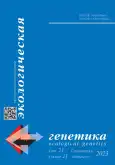Natural transformants of Camellia section Thea
- Authors: Chen K.1, Zhurbenko P.M.2,3, Danilov L.G.2, Matveeva T.V.2, Otten L.4
-
Affiliations:
- Shanghai Chenshan Botanical Garden
- Saint Petersburg State University
- Komarov Botanical Institute, Russian Academy of Sciences
- Institut de Biologie Moléculaire des Plantes
- Issue: Vol 21 (2023): Спецвыпуск
- Pages: 57-58
- Section: Genetically modified organism. The Нistory, Achivements, Social and Environmental Riscs
- Submitted: 17.08.2023
- Accepted: 05.09.2023
- Published: 04.12.2023
- URL: https://journals.eco-vector.com/ecolgenet/article/view/568588
- DOI: https://doi.org/10.17816/ecogen568588
- ID: 568588
Cite item
Full Text
Abstract
Horizontal gene transfer (HGT) plays an important role in plant evolution and plant development. Agrobacterium-mediated gene transfer leads to the formation of crown galls or hairy roots, due to expression of transferred T-DNA genes. Spontaneous regeneration of transformed cells can produce natural transformants carrying cellular T-DNA (cT-DNA) sequences of bacterial origin. HGT from Agrobacterium to dicots is remarkably widespread. The production of naturally genome modified plants could play a role in plant evolution and environment.
Among these natural GMOs (nGMOs) there are the tea plants. Camellia sinensis var. sinensis cv. Shuchazao contains a single 5.5 kb cT-DNA fragment organized as imperfect inverted repeat with three inactive genes. 142 Camellia accessions, belonging to 10 of 11 species of the section Thea, were studied for the presence of cT-DNA alleles. All of them contain the cT-DNA insert, indicating that they are resulted from the single transformed event. Allele phasing showed that 82 accessions were heterozygous for T-DNA alleles, 60 others were homozygous. A phylogenetic analysis of all found alleles showed existence of two separate groups of them, further divided into subgroups. The alleles of the different Camellia species were distributed mosaically over groups, and different species showed very similar T-DNA alleles. This indicates that the taxonomy of Thea requires revision. The nucleotide divergence of the imperfect cT-DNA repeats indicates that the age of cT-DNA insertion is about 15 mya, which is earlier then emergence of section Thea [1]. We present a working model for the origin and evolution of nGMO plants derived from allogamous transformants.
Full Text
Horizontal gene transfer (HGT) plays an important role in plant evolution and plant development. Agrobacterium-mediated gene transfer leads to the formation of crown galls or hairy roots, due to expression of transferred T-DNA genes. Spontaneous regeneration of transformed cells can produce natural transformants carrying cellular T-DNA (cT-DNA) sequences of bacterial origin. HGT from Agrobacterium to dicots is remarkably widespread. The production of naturally genome modified plants could play a role in plant evolution and environment.
Among these natural GMOs (nGMOs) there are the tea plants. Camellia sinensis var. sinensis cv. Shuchazao contains a single 5.5 kb cT-DNA fragment organized as imperfect inverted repeat with three inactive genes. 142 Camellia accessions, belonging to 10 of 11 species of the section Thea, were studied for the presence of cT-DNA alleles. All of them contain the cT-DNA insert, indicating that they are resulted from the single transformed event. Allele phasing showed that 82 accessions were heterozygous for T-DNA alleles, 60 others were homozygous. A phylogenetic analysis of all found alleles showed existence of two separate groups of them, further divided into subgroups. The alleles of the different Camellia species were distributed mosaically over groups, and different species showed very similar T-DNA alleles. This indicates that the taxonomy of Thea requires revision. The nucleotide divergence of the imperfect cT-DNA repeats indicates that the age of cT-DNA insertion is about 15 mya, which is earlier then emergence of section Thea [1]. We present a working model for the origin and evolution of nGMO plants derived from allogamous transformants.
About the authors
Ke Chen
Shanghai Chenshan Botanical Garden
Email: chenke@csnbgsh.cn
ORCID iD: 0009-0002-3432-2561
Shanghai Key Laboratory of Plant Functional Genomics and Resources
Taiwan, Province of China, ShanghaiPeter M. Zhurbenko
Saint Petersburg State University; Komarov Botanical Institute, Russian Academy of Sciences
Author for correspondence.
Email: pj_28@mail.ru
ORCID iD: 0000-0002-2102-4568
SPIN-code: 9433-1965
Researcher, Laboratory of Biosystematics and Cytology
Russian Federation, Saint Petersburg; Saint PetersburgLavrentii G. Danilov
Saint Petersburg State University
Email: lavrentydanilov@gmail.com
SPIN-code: 7424-8745
Department of Genetics and Biotechnology
Russian Federation, Saint PetersburTatiana V. Matveeva
Saint Petersburg State University
Email: radishlet@gmail.com
ORCID iD: 0000-0001-8569-6665
SPIN-code: 3877-6598
Dr. Sci. (Biol.), Professor, Department of Genetics
Russian Federation, Saint PetersburgLéon Otten
Institut de Biologie Moléculaire des Plantes
Email: leon.otten@ibmp-cnrs.unistra.fr
ORCID iD: 0000-0003-1122-7684
Institute of Plant Molecular Biology
France, StrasbourgReferences
- Chen K, Zhurbenko P, Danilov L, et al. Conservation of an Agrobacterium cT-DNA insert in Camellia section Thea reveals the ancient origin of tea plants from a genetically modified ancestor. Frontiers in Plant Science. 2022;13:997762. doi: 10.3389/fpls.2022.997762
Supplementary files










